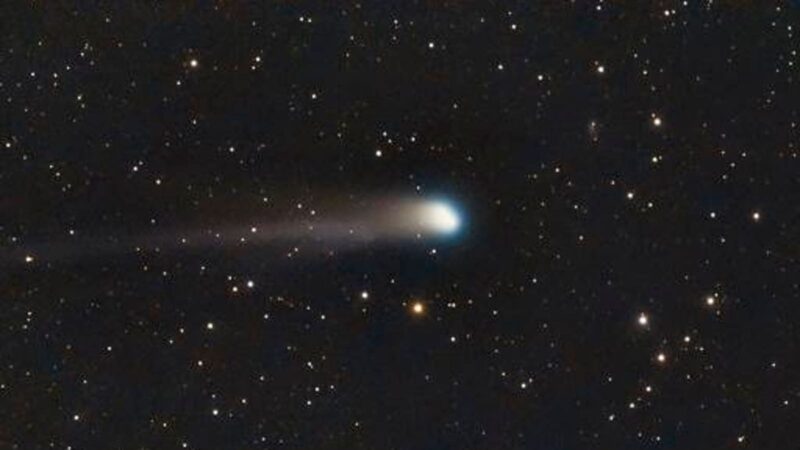Topline
Two green comets will reach their minimum distance from Earth, likely peaking in brightness, after sunset on Monday, Oct. 20, just hours before the peak of the annual Orionid meteor shower, itself the product of the famous Halley’s comet. Comet Lemmon (also called C/2025 A6) and Comet SWAN (C/2025 R2) get closest to Earth early this week at 55 and 24 million miles from Earth, respectively, and could be visible to the naked eye. Ditto the 20-or-so “shooting stars” from the meteor shower. The rare sky show will unfold under a new moon, ensuring dark skies worldwide.
Comet Lemmon (C/2025 A6) as imaged using a Seestar S30 smart telescope from New Brunswick, Canada, by Stéphane Picard at Cliff Valley Astronomy, on Oct. 4, 2025.
Stéphane Picard, Cliff Valley Astronomy (used with permission)
Key Facts
The comets are visible in the northwest (Lemmon) and southwest (SWAN) about 90 minutes after sunset. SWAN will be visible beneath the Summer Triangle stars while Lemmon will move more quickly across the sky beneath the Big Dipper.
The easiest way to find the comets in the night sky is to use the finder charts at In-The-Sky.com or stargazing apps such as Sky Guide, Stellarium and SkySafari.
With Comet Lemmon shining at magnitude +4.9 and Comet SWAN a little dimmer at magnitude +5.9, those in a Dark Sky Place or somewhere that looks dark on a light pollution map may be able to see them with the naked eye. However, it’s very likely that 8×42 or 10×50 binoculars will be required to see them.
The Virtual Telescope Project will stream live images of both comets from 17:30 UTC (1.30 p.m. EDT) on Monday, Oct. 20, using robotic telescopes installed in Manciano, Italy.
Skywatchers wanting to get a view of one or both of Comet Lemmon and Comet SWAN should try this week. As well as the brightness of comets being famously hard to predict (both could undergo an outburst and either brighten or fade at any time), moonlight will begin to interfere with observations by next weekend, making this coming week the best time to see the comets.
The Orionid meteor shower peaks on Oct. 21-22, producing about 20 meteors per hour under clear, dark skies. They will most likely be best seen after midnight through dawn, when the constellation Orion rises high in the southeast.
Comet Lemmon can be seen before dawn on Oct. 20— the best time will be 6:00 a.m. EDT.
Stellarium
When And Where To See The Comets
The best time to spot Comet Lemmon and Comet SWAN on Monday, Oct. 20, is during a 30-minute window starting about 90 minutes after sunset where you are. Both are visible after sunset but in opposite parts of the sky — Lemmon in the northwest, SWAN in the southwest. For New York City, where sunset is at 6:05 p.m. EDT, the ideal time for evening viewing is 7:35-8:05 p.m. EDT.
Comet Lemmon can also be seen before dawn — but not for long. Look during a 15-minute window beginning about 75 minutes before sunrise. With sunrise at 7:13 a.m. EDT in New York, the best time will be about 6:00-6:15 a.m. EDT — though earlier observations may also reveal the comet rising in the northeast.
The best time to see Comet Lemmon on Oct. 20 will be 90 minutes after sunset.
Stellarium
How To Find Comet Lemmon
Distance from the sun: 64.1 million miles (103.2 million kilometers)
Distance from Earth: 55.5 million miles (89.3 million kilometers)
Before sunrise, the comet will be in the northeast. The Big Dipper’s handle — which will point down toward the horizon — can be used to find it. Trace the stars of the Big Dipper’s handle in an arc, or banana-shape, to go in a curve down to the north-east horizon. From New York, the comet will stand about 6 degrees high at 6:00 a.m. EDT, and though it will climb higher as dawn approaches, after about 15 minutes, the sky will be bleached. Venus rises at about the same time.
After sunset, look for Comet Lemmon two-thirds of the way along a line between Alkaid — the bright star at the end of the Big Dipper’s handle — and bright star Arcturus farther west. Its height above the horizon varies by location, but from New York it will appear about 17 degrees above the northwest horizon at 7:35 p.m. EDT — roughly the width of four outstretched fingers held at arm’s length — and will gradually sink as twilight deepens.
The best time to see Comet SWAN on Oct. 20 will be 90 minutes after sunset.
Stellarium
How To Find Comet Swan
Distance from the sun: 91.7 million miles (147.6 million kilometers)
Distance from Earth: 24.4 million miles (39.2 million kilometers)
Blueish-green Comet SWAN will be visible in binoculars on Monday, Oct. 20, low in the southwest after sunset. SWAN will be in the constellation Sagittarius, above the famous “Teapot” asterism, but also below the bright star Altair in the Summer Triangle. It lies in front of the Milky Way’s dense star fields, which will be visible behind the comet in binoculars.
The best time to look for Comet SWAN will be a 30-minute window beginning about 90 minutes after sunset where you are. For New York City, sunset is 6:05 p.m. EDT, so the ideal viewing time will be from 7:35-8:05 p.m. EDT (though it will be visible until around 11:00 p.m. EDT). The comet’s height above the horizon will vary depending on your location, but from New York, it will be around 34 degrees up as it becomes visible.
Check my feed every day this month for a daily “comet tracker” with finder charts and tips for viewing Comet Lemmon and Comet SWAN from mid-northern latitudes. Also read How To Photograph The Green Comets, Best Stargazing Apps For Finding The Comets and 25 Dark Sky Parks In The U.S. To See The Comets.








